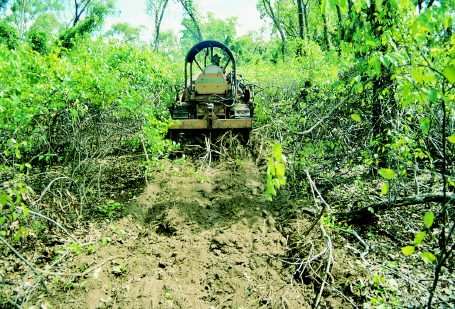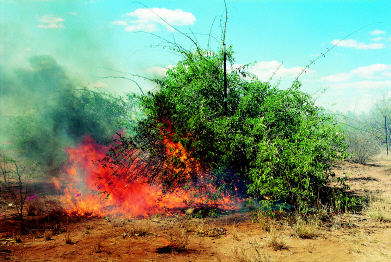|

Mechanical weed removal using a dozer (Photo
courtesy of
Queensland Government,
Department of Natural
Resources and Mines).
|
Manual cultivation
Hand pulling is the oldest and one of the most effective mechanical
methods, as human energy is directly
utilised. It is of minor value to the control of established perennials as underground parts are usually not disturbed. Hoeing is a widely used technique in the tropics. It is a highly effective method of weed control, however it is labour intensive.
Machine tillage (cultivation)
This can involve any implement powered by animals or machines and the
method is often less effective than manual methods. It is generally
effective against annuals and shallow rooted biennials but may not kill
deep rooted biennials. It may be applied before (cultivation) or after
(tillage) a crop emerges and the mode-of-action is to bury small weeds, pull
up others by loosening the soil around the roots and kill the plant by
desiccation. Tillage is used to prepare the land for furrow
irrigation but tends to create favourable conditions for weed seed
germination. Deep rooted perennials are controlled only by depletion of
food reserves through continuous destruction of top growth.
Mowing and cutting
Sickles, scythe, axes, and mowers have only a limited value as a means of
weed control. Their primary aim is to restrict unsightly weed growth. They
are commonly used along road sides and in waste places. These methods may
help control weeds when applied at or before the bud stage because they
prevent seed production. They also deplete food reserves, especially in
perennials. Generally, mowing is ineffective against prostrate or short
weeds growing close to the ground.
Flooding, dredging, draining, and chaining
Flooding deprives weeds of air and the ability to carry out
photosynthesis. It is only effective when the roots and shoots are
covered and when the situation prevails for a sufficiently long
period of time. Its success is confined to terrestrial plants.
Dredging, draining, and chaining are techniques that can be used on
aquatic weeds.
|

Burning rubber vine plants (Photo
courtesy of Queensland
Government,
Department of Natural
Resources and Mines).
|
Heat
Fire is often used to burn accumulated debris that is a health
hazard or is unsightly especially on railroads, canal banks,
drainage ditches and road sides. Flaming kills young plants if
their cambium reaches 50oC. To use this technique the crop plant
must be larger than the weeds, have woody stems, be resistant to
intense heat and the flame should be directed towards the ground.
The technique is used in cotton, sugarcane and soybean crops.
Smothering with non-living materials
Hay, manure, grass clippings, straw, sawdust, wood chips, rice
hulls, paper, and plastic film can be used to completely exclude
light from the growing weed. This prevents photosynthesis and
further growth. Cost of materials and residues make this an
expensive option.
[ Back ] [ Next ]
|

